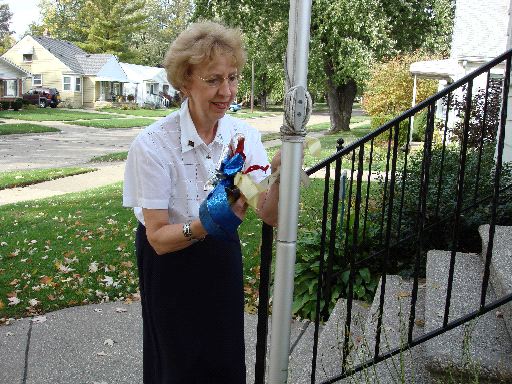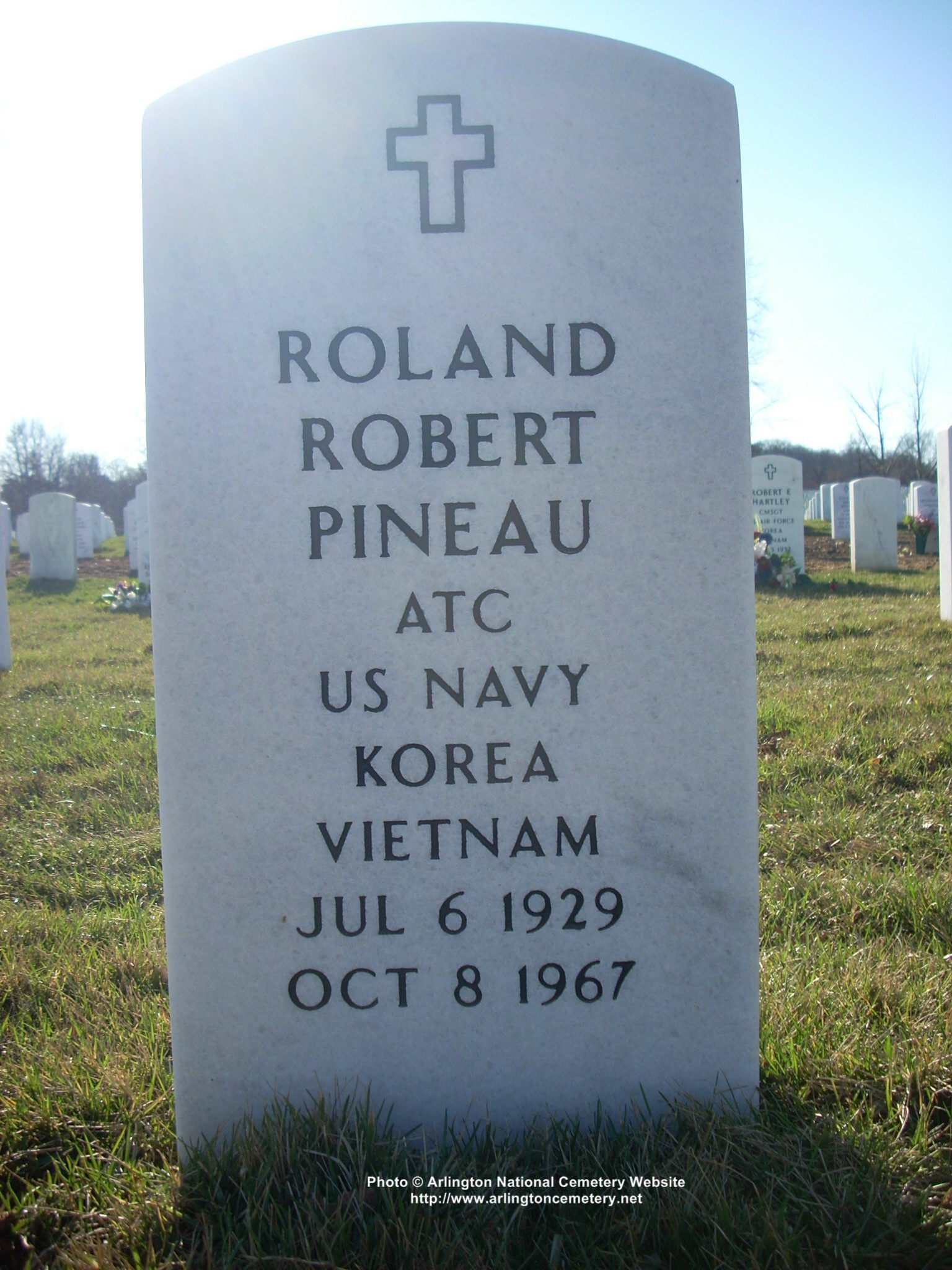Full Name: ROLAND ROBERT PINEAU
Date of Birth: 7/6/1929
Date of Casualty: 10/8/1967
Home of Record: BERKLEY,MICHIGAN
Branch of Service: NAVY
Rank: ATC
Casualty Country: SOUTH VIETNAM
Casualty Province: QUANG NAM
Status: MIA
Name: Roland Robert Pineau
Rank/Branch: E7/US Navy
Unit: Early Warning Squadron 111, Detachment 34, USS ORISKANY (CVA34)
Date of Birth: 06 July 1929
Home City of Record: Berkley Michigan
Date of Loss: 08 October 1967
Country of Loss: South Vietnam
Status (in 1973): Killed/Body Not Recovered
Aircraft/Vehicle/Ground: E1B
Other Personnel in Incident: Raul A. Guerra; Norman L. Roggow; Donald F. Wolfe; Andrew G. Zissu (all missing)
Source: Compiled by Homecoming II Project with the assistance of one or more of the following: raw data from U.S. Government agency sources, correspondence with POW/MIA families, published sources, interviews: 15 March 1990. Updated by the P.O.W. NETWORK 1998.
REMARKS: CRASH SIT CNFM – NO RECOV POSS – J
SYNOPSIS: The USS ORISKANY was one of several U.S. aircraft carriers to be semi-permanently stationed on Yankee Station in Vietnam. Its attack wings flew against varied targets in North Vietnam including bridges, ammunitions stores, highways, and railroads. 1967 was a particularly active year for all carriers, and the ORISKANY was no exception.
On October 8, 1967, Lieutenant (jg) Andrew G. Zissu was the pilot of an E1B aircraft which launched from the ORISKANY on a morning combat mission in support of a major strike over North Vietnam. Zissu’s crew that day included Lieutenant (jg) Donald F. Wolfe, Lieutenant (jg) Norman L. Roggow, and ATC Roland R. Pineau. Also on board was one passenger, Seaman Raul A. Guerra, listed as a Journalist Petty Officer, Third Class.
The E1 aircraft was a propeller aircraft that was generally used by the Navy for Early Warning operations, or for flight assistance in bombing missions. Typically, the slower moving E1, unable to keep up with faster moving jet aircraft, would be used in a standoff position for radar jamming while the jet aircraft executed their mission.
At the completion of the combat mission, the aircraft was sent to Chu Lai, South Vietnam for refueling before the next mission. The aircraft landed at Chu Lai, refueled and took off again for another mission on the back to the USS ORISKANY. Immediately after takeoff radio contact with the ship was made and the crew reported that their flight was airborne and would be ready for its mission upon arrival. In addition, radio contact was established immediately after takeoff with DaNang Radar who was to keep them under observation during their trip north to the ship. They planned to fly directly over DaNang and then proceed to the ship. As they approached DaNang radar on a northwesterly course, radar contact was lost, however, radio contact was maintained with the aircraft. After overflying DaNang, radar contact was again established at a point approximately 10 miles northwest of DaNang in mountainous terrain. An immediate right turn was recommended by the radar controller to a northeasterly course. The pilot acknowledged that he was turning, right before he could complete his turn, radar and radio contact was lost simultaneously and an alert issued by DaNang radar immediately.
An aggressive search and rescue and operation was conducted, however, efforts were hampered because of adverse weather, low visibility, and rain. The weather improved and the aircraft wreckage was sighted, scattered over a wide area on a sheer face of Monkey Mountain near Da Nang. A fellow detachment officer flew over the crash site in an Air Force Helicopter and positively identified the wreckage as that of the missing E1B. Because of the hazardous terrain, the crash site was inaccessible by helicopter and too dangerous for ground parties to be sent in. Due to the terrain characteristics at the crash site, the force of the impact into the face of the ridge, and the obvious complete destruction of the aircraft, it was not believed that there were survivors.
No sign of survivors was noted. It was not possible to recover remains, and all personnel aboard the aircraft were declared Killed/Body Not Recovered. The Navy did not rule out the possibility of hostile interference, although the general feeling was that inclement weather was the cause of the crash.
The Defense Intelligence Agency further expanded the men’s classification to include an enemy knowledge ranking of 3. Category 3 indicates “doubtful knowledge” and includes personnel whose loss incident is such that it is doubtful that the enemy wound have knowledge of the specific individuals (e.g. aircrews lost over water or remote areas).
The Navy men on board the E1B lost on October 8, 1967 were listed as killed, body not recovered.
NOTE: ATC Pineau’s body has been recovered and identified. He will be buried with full military honors at Arlington National Cemetery in October 2007.
PUBLISHED: Tuesday, October 23, 2007
Berkley man killed in Vietnam 40 years ago laid to rest
Navy chief buried at Arlington, memorialized at home
By Catherine Kavanaugh
Courtesy of the Daily Tribune of Michigan
Mary Pineau of Berkley removes a yellow ribbon Monday from the flagpole outside her house.
BERKLEY, MICHIGAN — Forty years after Roland Pineau died following a combat mission over Hoi Mit Mountain, Vietnam, the family of the chief radar technician has closure.
On Monday, his sister, Mary Pineau, cut a weather-worn yellow ribbon from the flagpole outside the Kenmore Street house where they grew up. It was a quiet moment for her following a memorial service Saturday for the dedicated serviceman who enlisted in the U.S. Navy in 1946 at age 17, and served two years in the Korean War and three tours of duty in Vietnam.
ATC Pineau was killed in what is believed to be a weather-related plane crash on October 8, 1967. His remains finally were identified this year following decades of communications between the family and the military.
“We’ve done our job,” Pineau said. “We brought him home. We’ll save the yellow ribbon, but we’ll continue to fly the POW/MIA flag in honor of others who are still unaccounted.”
Pineau and her sisters, Lynn Kalil of Royal Oak and Lorraine Gensel of Pennsylvania, described Saturday’s service at Our Lady of LaSalette as a wonderful tribute to their brother, who held down six jobs to earn money to take flying lessons when he was 15.
“He loved adventure. He relaxed by sky diving,” Gensel said.
Outside the church, members from American Legion Post 374 formed an honor guard line. Inside, four priests officiated and Vietnam veterans shared the Bible readings.
“There was a joyfulness to it — to finally acknowledging his 21 years of military service” Pineau said. “We grieved 40 years ago and were sad not to be able to have a funeral.”
Then, in June, relatives were notified that remains either discovered in an excavation or turned over by Vietnamese citizens — perhaps both — matched Pineau. Arrangements were made for his nephew, Todd Kalil, to escort the remains to Arlington National Cemetery for burial October 9, 2007.
“The great respect they showed was incredible,” Pineau said. “We felt such a sense of relief that he was honored at last. That was 40 years and one day from when his plane crashed.”
In the spring of 1967, Pineau could have retired from the Navy, but he volunteered to return to Vietnam on the USS Oriskany, where he was placed in charge of avionics. He was the chief aviation technician on an E-1B Tracer sent on a combat mission over the Gulf of Tonkin on October 8, 1967.
Tracer crews relayed information to help intercept enemy aircraft, direct attacks on targets, monitor strikes over North Vietnam and get messages to units beyond the radio range of the aircraft carrier.
Pineau and the four other men on the twin turboprop completed their mission and refueled for a new assignment at an airfield in ChuLai on the coast of South Vietnam. They took off in terrible conditions with monsoon winds and no visibility. They were ordered back to the USS Oriskany, but lost radio and radar contact on their return to the carrier.
The weather thwarted attempts at an extensive search and rescue. Two days later, a search helicopter located the wreckage on a cliff ledge of Hoi Mit Mountain. The hazardous terrain and enemy in the area prevented a ground party from going to the site.
No one could have survived the crash, a report concluded. The Tracer had exploded and burned upon impact.
Three days after Robert and Elizabeth Pineau of Berkley were informed the eldest of their six children was missing, they received a telegram that started, “It is with utmost regret …”
The family was devastated.
“We were celebrating Todd’s first birthday,” Pineau said.
The telegram said the crash occurred on a steep mountain slope 14 miles northwest of DaNang, South Vietnam, and the Navy couldn’t risk more lives to recover the remains of the crew.
“The added grief of not being able to provide a burial was heartbreaking,” according to Gensel.
The family never gave up hope, however. In May 2005, an excavation at the mountain identified the wreckage and possible bones, teeth, boots and other personal effects. There also were reports some remains had been removed from the crash site in the 1980s and stored or buried.
In November 2006, a Vietnamese citizen turned over a box with some of those remains, which were repatriated and sent for testing. This June, the Pineau family met with the National League of POW/MIA Families in Washington, D.C., and learned about the DNA match.
The family finally could plan a burial and memorial service for the man who played with model planes as a child and made his first solo flight on his 16th birthday.
“He knew of the dangers and that he might not return from a mission,” Pineau said. “But he wanted to serve his country, fight communism and support his squadron.”
The family has about 150 letters he wrote during his 21 years in the service. Gensel and Pineau have compiled them along with his life story for future generations.
While holding pictures of a wreath-laying ceremony at the Tomb of the Unknowns at Arlington and bagpipers at the legion hall Saturday, Pineau said, “Now we can finish the story.”
Michael Robert Patterson was born in Arlington and is the son of a former officer of the US Army. So it was no wonder that sooner or later his interests drew him to American history and especially to American military history. Many of his articles can be found on renowned portals like the New York Times, Washingtonpost or Wikipedia.
Reviewed by: Michael Howard


